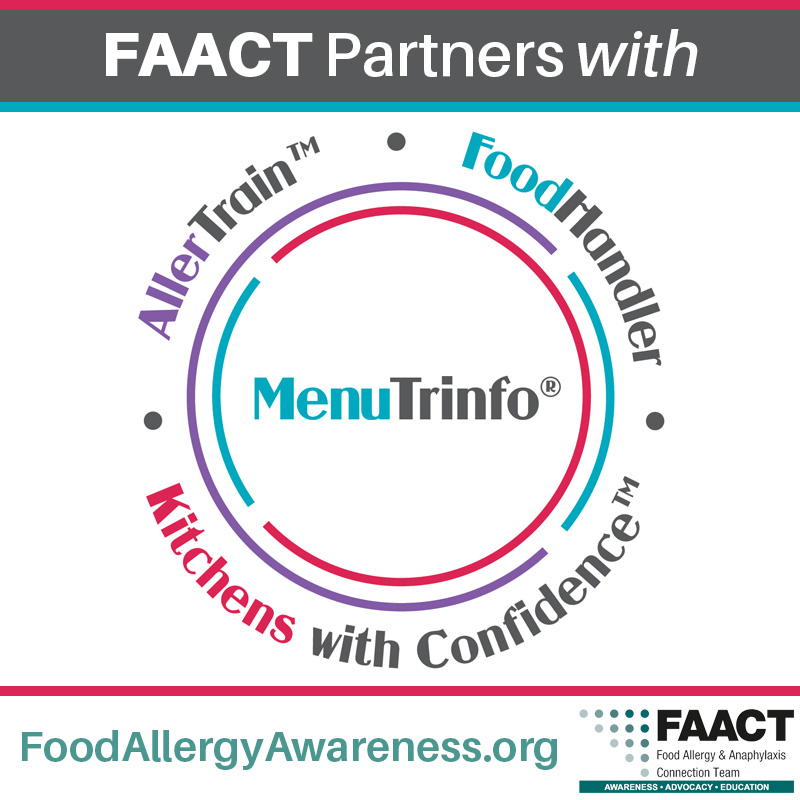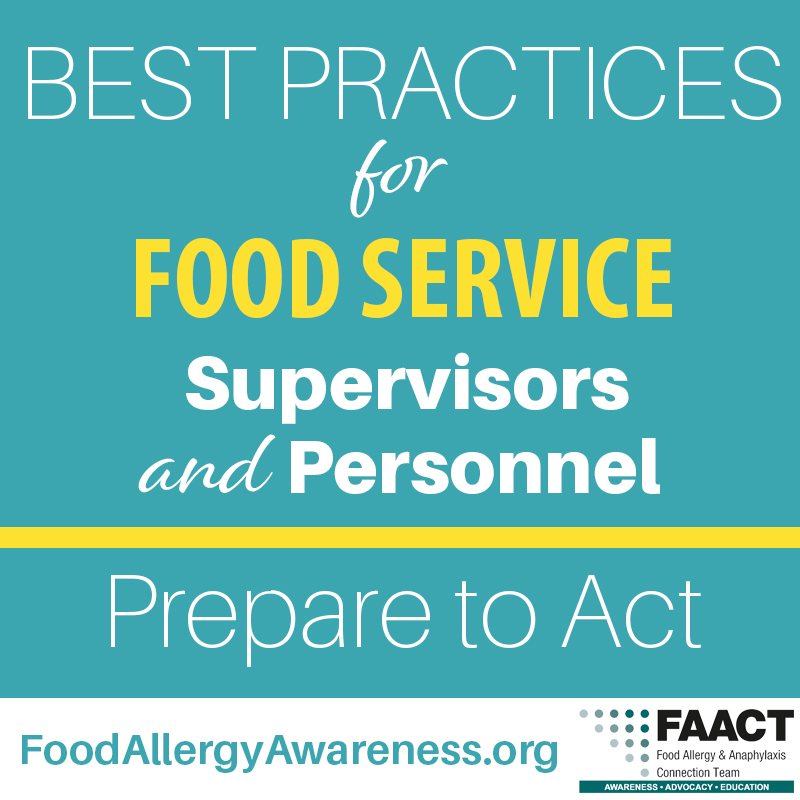Education
For School Personnel
Back to Category View
FAACT and MenuTrinfo® Partner on Food Service Training
For the millions of students living with food allergies, eating at the school cafeteria is not merely a convenience, it’s a gamble – with potentially fatal consequences. The food service industry’s food allergy expert, MenuTrinfo®, partnered with the nation’s leading food allergy education and advocacy group, the Food Allergy & Anaphylaxis Connection Team (FAACT), to make serving students with food allergies safer.
Together, FAACT and MenuTrinfo® are providing leading-edge food allergy education, risk-reduction strategies, and emergency preparedness plans to food service facilities so they can safely serve students living with food allergies as well as their families, friends, and colleagues.
The AllerTrain™ suite of courses by MenuTrinfo® was launched in 2011 to meet the growing need for food-allergy and gluten-free training within the food service industry. Over the past decade, it has evolved into a wide variety of training options, led by the food service industry experts, designed to suit the needs of every member of the food service industry. The ground-breaking partnership with FAACT brings expert oversight and additional content vetted by FAACT’s Medical Advisory Board to achieve even stronger and clearer education for those who complete the training.
With both an eLearning platform and live workshops taught by Master Trainers, AllerTrain™ is an accessible option for every style of learner. MenuTrinfo® is the only company that offers an in-person food allergy training option, which is the chosen teaching to have students retain high levels of information.
AllerTrain U™ for the college and university settings and AllerTrain Lite™ are the programs that dining services looking to be “Certified Free-From” locations have turned to for the knowledge their staff must have to deliver food services with confidence each and every time. Both are ANAB/ANSI-accredited training courses that go further to meet state- and county-specific training mandates. You can find a map online showing college and universities that have utilized the AllerTrain™, AllerTrain U™, and AllerTrain Lite™ training.
The courses teach food service professionals:
- Top foods that cause allergic reactions
- Proper protocol for preparing food to avoid cross-contact with allergens
- How to better serve students with special dietary needs
- Recommendations for policy implementation
- Information on current and pending legislation in each state
AllerTrain™ and FAACT are helping food service professionals on all levels to better handle gluten-free and food allergen requests, avoid food allergy-related incidents, and prepare for onsite food allergy emergencies should they occur.
Has your college/university food service division provided certified allergen training for staff? If not, please consider using the AllerTrain™ U and/or AllerTrain™ programs to train all food service personnel. It’s the best way to ensure the safety of your students living with food allergies.
MenuTrinfo® also offers the Kitchens With Confidence™ program, which certifies food service locations that have been assessed through rigorous audits on methods, standards, policies, and understanding to serve persons with special dietary needs, specifically food allergies. A map of certified locations available on the AllerTrain™ website is a useful tool for students going to college with food allergies.
Visit AllerTrain™ to schedule your training today!

Best Practices for Food Service Supervisors and Personnel
- Follow the guidance and utilize resources available from your local food service director, local board of heath, the U.S. Department of Agriculture (USDA), or registered dietitians trained in managing food allergies.
- Collaborate with your local food service director, the school staff and nurse, parents, and students’ physicians to share pertinent information about each student with food allergies prior to the start of each school year.
- Identify students with food allergies and become familiar with his or her allergy and anaphylaxis emergency care plan. School staff should keep the emergency care plan in a location that is easily accessible by food service personnel.
- Ask parents to provide you with a signed medical statement from the student’s physician outlining the management of the student’s allergens and avoidance measures.
- Know where each student’s emergency medications are stored (if they are not self-carried) and be trained in the administration of each student’s prescribed epinephrine auto-injector and any other necessary medications.
- Have a policy in place regarding label reading and keep a list of ingredients and product updates in appropriate and convenient areas, updating as necessary.
- Use separate utensils, pots, pans, cutting boards, etc., when preparing foods for food-allergic students. Learn how to effectively clean and store these items.
- Follow policies and guidelines to prevent allergic reactions and cross-contact from occurring.
- Learn about proper cleaning and removing allergens from surfaces and hands.
- Ensure food service staff clean all tables and chairs for use by students with food allergies.
- Attend all training and informational meetings on each student with a food allergy.
- Provide training to all cafeteria personnel on how to accommodate students with food allergies during mealtimes and when snacks are provided, including special events.
- Provide food service staff with resources to help assist in the management of students with food allergies.
- Implement and review cross-contact procedures. Visit FAACT’s Cross-Contact page for more information.
- Meet with parents upon request to review cafeteria menu items and ingredients and cafeteria procedures. This is especially important for students who are transitioning from half-day kindergarten to a full-day first grade or re-entry after an anaphylactic reaction at school.
- Display an ingredient label for each food on the cafeteria buffet line. This provides students the ability to self-educate as well as self-advocate.